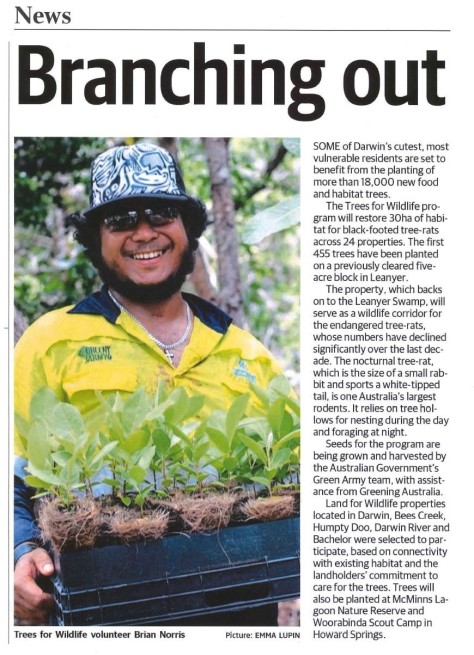Exciting news- The nest box design is finalised and the men’s shed in Palmerston is making 150 for the Land for Wildlife program.
What wildlife are the nest boxes for ?
This nest box design is made is to provide a nesting place for the Black-footed Tree-rat, which is a listed threatened species in the Northern Territory and Australia wide. For some reason this species still seems to be more common in the Darwin and rural area and declining in locations further away. It is thought that its overall decline is due to a lack of tree hollows (where it nests) and a decline in mid story fruiting trees (its food), and this is mostly associated with too frequent and hot fire and of course land clearing.
 Land for Wildlife coordinator Emma with men’s shed member Max and the prototype nest box
Land for Wildlife coordinator Emma with men’s shed member Max and the prototype nest box
Why this design?
Our nest box design is based on a design by Leigh-Ann Woolley, a researcher at Charles Darwin University. The entrance hole has been reduced to 85mm to discourage possums, but allow tree rats and other small native rodents, there is a small lip over the entrance hole to discourage birds as well as add rain protection. This design has been tried and tested very recently at Coburg Penninsular, with the Black-footed tree rat, and other smaller native mammals being recorded using the design (where 100 of this larger design were installed and 100 of a smaller design)
The final design has a slightly larger roof and will have extra brackets on the rear for attaching.
Who is making them?
The Palmerston men’s shed is a community workshop area for men to gather, develop skills, and undertake different activities. Essentially Men’s Sheds are about increasing the well being of men by fostering social connectedness and increasing self-esteem.
The shed at Palmerston makes a huge variety of items, mainly from wood but have recently specialised in making many different designs of nest boxes for native wildlife. Their last project made nest boxes for a “Darwin Wildlife Sanctuary” project for urban gardens. The organisation also sell nest boxes at the Rural Fred’s Pass market on a Saturday for various species, including parrots, sugar gliders, possums and reptiles. They range from $30- $45 each.

The men’s shed members model our prototype nest box.
Where are they going ?
Early this year we asked members of our Land for Wildlife program if anyone wanted to sign up to this “Enhancing habitat”. We have room for 30 properties to be involved and all 30 spaces were filled by enthusiastic landholders, who live on a variety of properties, which include at least 1 hectare of wildlife habitat, or re-vegetating habitat. The properties involved are located in Leanyer (Darwin), Howard Springs, Girraween, Humpty Doo, Bees Creek, Bachelor, the Adelaide River area and Katherine and range from 5 acres properties to 2000 acres and also includes a s
The landholders have already pledged to manage part of their property for wildlife habitat which includes weed and fire management and where possible to enhance it habitat, this project does just that. Each landholder receives up to 5 nest boxes as well as 50 native food plants for the Black-footed Tree-rat to plant on their property. Other measures that can encourage native mammals include good pet ownership, trapping for feral cats, leaving fallen logs and leaf litter and leaving standing dead trees (but making them safe if near used areas).
The advice given about choosing where to install nest boxes is –
- Choose over-story long lived trees, such as Eucalyptus, Ironwoods and Lophostemons that have good canopy cover.
- Choose trees in an area with other vegetation and protection.
- Choose trees that do not already have tree hollows, as the tree does not really need “enhancing” as habitat and this also may cause competition with species uptake and proximity.
- If trees have a fork it is often easy to install the nest box in this, if not the recommended height is 2-3 m (far enough off the ground for safety and close enough for humans to check the boxes with a ladder)
- Install nest boxes at least 30 meters apart.

Land for Wildlife, Trevor member collects his habitat enhancing plants for the Black-footed Tree-rat
Is any data collected?
Yes– those involved choose the trees where they would like to install the nest boxes, which are at least 30 meters apart. Each nest box location is recorded with a GPS, a brief description of landscape type and 3 photographs taken of its location. A habitat condition survey is made of property / nest box locations.
The habitat condition is recorded by laying 2 transects centered on 2 of the nest box locations which are situated and in representative areas of varying habitat condition on each property. The transects are 50m long and record the nearest tree to the left and the right of the transect every 5m. The tree must be over 1.2m in height and its DBH (Diameter at Breast Height), species and presence of hollows is recorded. The ground cover and fire history is also recorded. This is all done by the project coordinator with involvement from the landholders.
These surveys will provide a sample overview of tree density (and recruitment), species diversity within tree species, presence of a mid story fruiting layer and presence of other tree hollows.

Land for Wildlife member Kim, helps do survey work as part of the project on her 20 acre property in Humpty Doo
After installation the nest boxes will be monitored, hopefully by landholders and also the coordinator, who will look for evidence of uptake after 6 months.
The initial survey information allows us to analyse whether the uptake of nest boxes varied with location and property situation and habitat condition and type.
The enhancing habitat workshop for participants
A workshop at the Territory Wildlife Park is scheduled for May 20th for those participating, where landholders will learn about the different species that may take up the nest boxes and their habits (and maybe even meet some of these creatures)..
They will also learn how to finish and install the nest boxes and listen to talks from those who have studied nest box enhancement.
The Remote Area Tree Services guys will also be demonstrating who to create habitat and hollows from fallen logs, old trees and items found on properties, with the assistance of a chainsaw.
There is also a Fire Workshop for members and interested others on 7th May for those attending to learn more about the affects of fire on wildlife habitat.

Above is an example of how to finish a nest box, this sample was made for us by Land for Wildlife member Niel Carpenter

Land for Wildlife Volunteer models another nest box, made by Neil who is trialing finishing techniques to camouflage different next boxes.
Who is funding this?
This project is funded by a Territory NRM Community grant and supported in kind by the Land for Wildlife Top End program (whose core funding is currently from Parks and Wildlife Commission NT).
Bunnings Palmerston has provided a donation of some materials towards nest box production.
We are looking for donations of paint to finish and camouflage the boxes as well as old hose for fixings.
 Land for Wildlife members Peter and Troy have been working hard to re-grow wildlife habitat on their 5 acre property in Leanyer.
Land for Wildlife members Peter and Troy have been working hard to re-grow wildlife habitat on their 5 acre property in Leanyer.




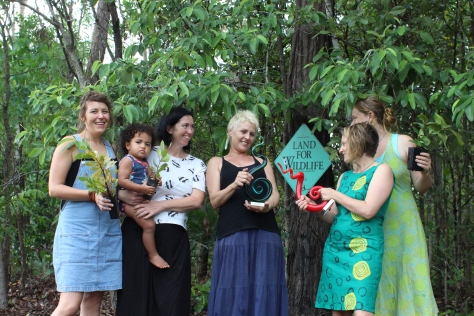











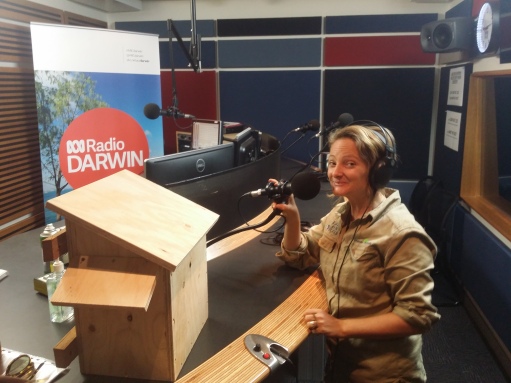





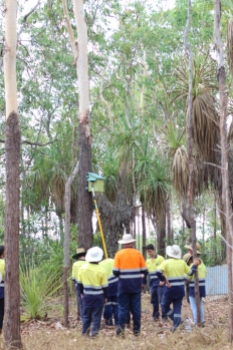

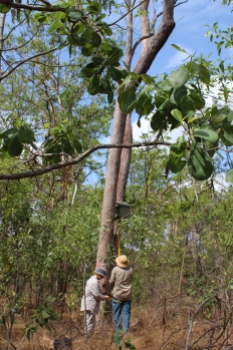



















 Dr Leigh-Anne Woolley, a researcher from CDU, gave an informative talk about her research into the decline of arboreal mammals in the NT and the use of nest boxes by these species. Leigh-Anne showed that nest boxes were used by several native mammals and the size of the hollow determined which animals were likely to use them.
Dr Leigh-Anne Woolley, a researcher from CDU, gave an informative talk about her research into the decline of arboreal mammals in the NT and the use of nest boxes by these species. Leigh-Anne showed that nest boxes were used by several native mammals and the size of the hollow determined which animals were likely to use them.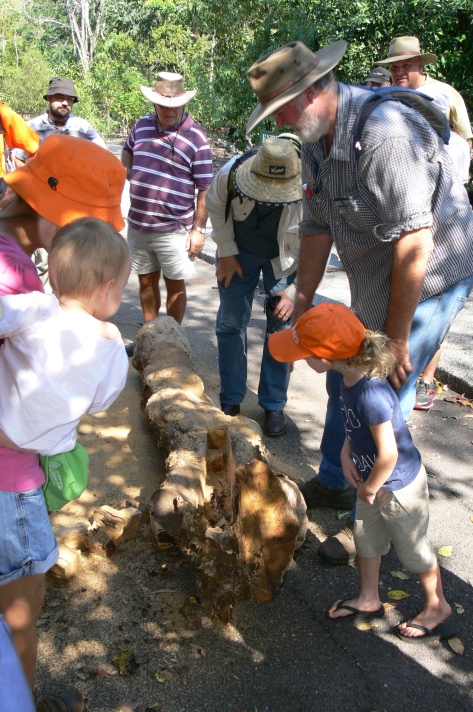
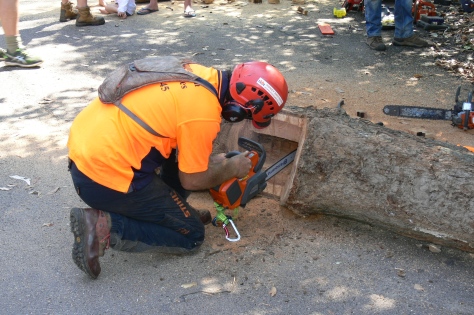
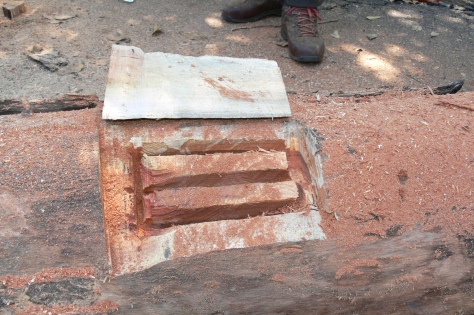




 Land for Wildlife coordinator Emma with men’s shed member Max and the prototype nest box
Land for Wildlife coordinator Emma with men’s shed member Max and the prototype nest box




